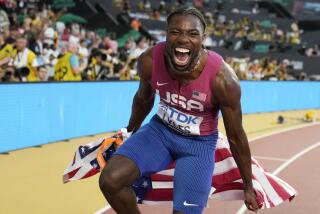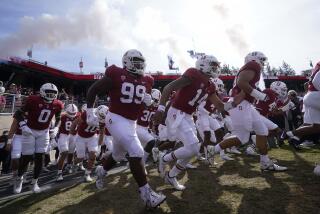ANALYSIS : Power Play to Reshape U.S. Track : Politics: After 10 years of nearly absolute control, Cassell is expected to ease his grip on The Athletics Congress.
- Share via
The management and direction of track and field in the United States for the last 10 years has largely been at the discretion of Ollan Cassell, executive director of The Athletics Congress, the sport’s national governing body.
Cassell has shepherded track and field through a decade that has been at once tumultuous and immensely profitable. There have been embarrassing drug scandals, but there also have been rewarding television contracts. TAC, a nonprofit organization, has gone from a volunteer-driven group with a negligible budget to one run by a full-time professional staff with a yearly budget of $10 million, believed to be the largest of any amateur sports federation.
In this time, Cassell’s power to make and implement policy has been nearly absolute. His management style has been marked by a hands-on approach with little delegation of authority or responsibility. In TAC’s management flow chart, everything was required to come across Cassell’s desk for his approval.
It has taken those in the sport the full 10 years to conclude that Cassell never really had the right to the power he wielded, that he was never supposed to formulate policy but merely carry it out. In track and field, it appears that the sport’s officials move at a considerably slower rate than the athletes.
Change, however slow, has at last arrived. The aftermath of a series of frank meetings among Cassell and athletes and officials has produced a new resolve from some unheard-from quarters.
“We are basically in the process of wresting the power back where it belongs, after a long, long time,” said one participant in the three meetings that have been held in the last two months.
TAC’s administrative structure is undergoing reorganization to give it a more streamlined look. The authority of the executive director will be cut back while at least two senior administrative positions will be added. There will be a new emphasis on marketing and public relations. A primary aim is to have more accountability and better communication, with the national office in Indianapolis more responsive to the concerns of TAC’s rank-and-file.
The planned changes are sweeping but come as by-products of the central concern that had been growing for years in TAC--about Cassell and his power. How could it happen that one man would ascend to control of such a huge organization and, for the most part, run it unchecked and unchallenged for a decade?
According to TAC President Frank Greenberg, two factors were at work: Cassell assumed more and more power, true, but he also was allowed to grow steadily more powerful because others in the organization failed to fulfill their obligations. Greenberg said that the staff in the national office, lacking any guidance or direction, eventually did whatever it wanted.
“There was a vacuum,” Greenberg said. “They try not to establish policy, but day to day, finally,
they have to. If they can’t find the president or some other officer, and a decision has to be made today, they make the decision. They are forced into it.
“The thing that brought it to a head was, the athletes felt that the executive director was making decisions and no one knew where the organization was going. It’s obvious that the executive committee will have to be more like a board of directors. They will have to meet every six weeks (or so). We have to have more communication.”
Part of the problem was with TAC’s vast bureaucracy and its myriad committees and boards. The executive committee, which carries tremendous power, has rarely met and has never served as an oversight group for Cassell’s decisions. Among the committee’s powers: The right to hire and fire the executive director.
Don Kardong, an executive committee member, said that until the special meetings this summer, he didn’t even know who else was on the committee. The executive committee consists of all TAC officers and heads of TAC sports committees, as well as members from an at-large group and the athletes. Its duties are clearly spelled out but, until now, they were rarely carried out.
“Up to this year, the executive committee has been a dinner during the convention and a lunch during the outdoor championships,” Greenberg said.
“I think Ollan’s in trouble,” said Julia Emmons, chairperson of the women’s long-distance running committee. “I don’t think that any member of the federation could have held his or her head up if things had continued. I don’t think any one person is greater than the federation. That can’t be allowed to happen.
“What is going on now is a redress of power. There are deeply felt feelings that if this thing does not work, he will go. If this restructuring doesn’t work, or Ollan balks, there is no question that he will go.”
Three meetings led to the proposed changes. The first was in Chicago on June 9. The second was in Cerritos on June 17 during the TAC national championships. But the most important, and by far the most heated, meeting was in Chicago July 7-8. There, Cassell faced a battery of tough questioners and, for perhaps the first time, heard in one place what had been disparate criticism.
“Ollan may have heard it all before,” Greenberg said, “But I’m not sure he had heard such unanimity.”
Present at the meeting were Edwin Moses and Harvey Glance, two of the four athletes who had resigned this summer from TAC’s drug-testing review board, protesting what they called the incompetence and mismanagement of TAC officials.
Their resignations created a controversy that drew attention to TAC’s bold but troubled drug-testing program. Further controversy was stirred after a story in The Times reported that documents indicated TAC officials had been inconsistent in drug enforcement policies.
Cassell was at the center of these questions and, as had been TAC policy, he said little. That, too, has been criticized by others in the federation.
“TAC has not had skillful public information,” Emmons said. “Ollan doesn’t understand it, and he doesn’t have a person who likes to handle it.”
Thus, the meetings were heavy with significance and agenda items. The third meeting, characterized by several participants as having been cordial but frank, held the most drama for Cassell. At many points, according to participants, he was asked to leave the room while executive committee members discussed his job performance more openly. During one of these discussions, one member, Stan Wright, asked that a vote of confidence be taken. Although the vote never occurred, at least one person present believed that if a vote had been taken, the mood in the room was definitely in favor of “no confidence” for Cassell.
Even without a vote, Cassell no doubt got the message. The question is whether he is willing and able to accept the changes and relinquish the power he has held for 10 years. Greenberg said he has seen nothing but positive signs that Cassell, 51, can accept the new structure. Others agree.
“I hear from enough people who know Ollan well who believe that he can make this change,” Kardong said. “If it doesn’t work, we go to Plan B, which, I suppose, will mean we will have to replace him.”
Several executive committee members likened this transition period to Cassell being placed on probation. What is the length of the probationary period?
“I’ll give him a year,” Emmons said.
In setting up a new TAC structure, the executive committee originally suggested four new senior management positions: directors of operations, marketing, communications, and administration.
A smaller group was assigned to take the suggestions and present a complete plan by the annual TAC convention in late November.
Emmons heads the committee that met Aug. 18-19 in Atlanta and refined the original suggestions. The new structure will create only two new senior positions under Cassell, one for operations and one for administration.
Emmons also stressed the need for better public relations, especially at a time when the sport and the federation are suffering from a credibility/image problem.
“We’ve reached a crisis point, certainly with the way that people in the sport perceive the problems and the way that the public does,” Kardong said.
Perhaps with that in mind, Cassell has taken an unprecedented step in public relations. Starting earlier this month in New York and continuing Monday in Los Angeles, he is conducting round-table discussions with athletes, coaches, agents, promoters and members of the media. These sessions are intended to evoke wide-ranging discussions about the state of the sport and what can be done to improve the situation.
The effort comes not a minute too soon.
Amateur sports, insofar as they are dependent on donations, are especially sensitive to public opinion. Track and field, which has been tainted by drug scandals and whose athletes often appear more greedy than talented, is becoming less and less attractive to major sponsors.
“The sport doesn’t have a good image,” Emmons said. “I don’t think I hear a death rattle. But I certainly see something that is not in good health.”
More to Read
Go beyond the scoreboard
Get the latest on L.A.'s teams in the daily Sports Report newsletter.
You may occasionally receive promotional content from the Los Angeles Times.











